The Perfume River is a stunningly picturesque canal that runs through the center of Hue, Vietnam’s old capital. Thanks to its breathtaking panoramas and historical significance, it has become a must-visit site for travelers looking to immerse themselves in Vietnam’s rich culture and history.
This post will look at the Perfume River’s various charms, from its natural beauty and serene ambiance to its cultural relevance and historical relics. Prepare to be enchanted by the magic of this lovely river!
See more: Thrilling River Exploration in Vietnam
Contents
History and Geography of the Perfume River
The Perfume River, or Huong River, is a 30-kilometer-long river that runs through the central Vietnamese city of Hue and has a rich historical and cultural value. The river flows from the Truong Son Mountains to the Tam Giang Lagoon, which connects to the East Vietnam Sea.

Flowers from orchards and gardens along the riverbanks fall into the water throughout autumn, creating a lovely perfume that drifts along with the river’s gentle current. The aroma is supposed to be particularly strong in the evening when the air is cooler, and the fragrance is more distinct.
The name “Perfume River” refers to the river’s distinctive natural aroma. For ages, the Perfume River has been a source of inspiration for poets, artists, and singers, and it has played a major part in Hue’s cultural and political history. Many historical events have occurred along the river, including battles, royal festivities, and religious rituals.
The river also contains many significant historical and cultural attractions, including the Thien Mu Pagoda, one of Vietnam’s oldest and most magnificent pagodas. Visitors can explore the beautiful construction of the pagoda as well as the stunning views of the river and surrounding countryside.
The Perfume River has played a significant part in the history and culture of Hue. The city served as the capital of Vietnam during the Nguyen Dynasty, and the river was an essential part of the city’s infrastructure. The river provided a water source for the city’s residents, as well as transportation for goods and people.
The river was also the site of several important battles during the Vietnam War. The Battle of Hue, which took place in 1968, was one of the longest and bloodiest battles of the war. The city and the river suffered significant damage during the conflict but have since been restored and are now popular tourist destinations.
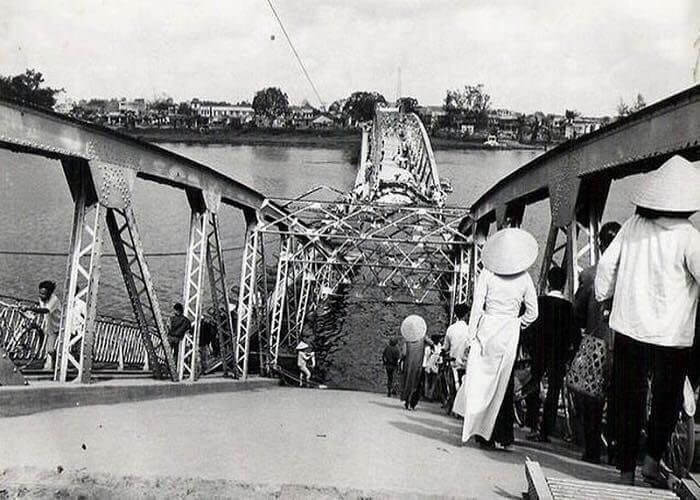
The Perfume River is still an important component of Hue’s daily life today. The river supports traditional sectors, including agriculture and fishing, and the expanding tourism industry.
The river’s cultural and historical importance and natural beauty make it a must-see for anybody visiting Hue. The Perfume River has something for everyone, whether they are interested in history, culture, or natural beauty.
Exploring the history and beauty of Vietnam’s Thu Bon River in this captivating journey.
The Role of the Perfume River in Shaping the Identity of Hue
The Perfume River is not only culturally and historically influential, but it also plays an important part in the daily lives of the people of Hue. The river is a critical water supply for agriculture and fishing, and many local villages rely on it for a living.
The fertile riverbanks are suitable for growing rice, vegetables, and fruit trees, staples of the native diet. The river also sustains many fishing towns that rely on it to catch fish, shrimp, and other seafood. Fish harvested in the Perfume River are sold in marketplaces across the city and are an important source of nourishment for many households.
In addition to supporting traditional industries, the Perfume River is a significant driver of the region’s economy through tourism. The river’s scenic beauty and cultural significance have made it a popular destination for visitors worldwide. Many tourists take boat tours to explore the landmarks and attractions along the river’s banks, including the Thien Mu Pagoda and the Imperial City of Hue.

The tourism industry has created jobs and income for many residents of Hue. In recent years, the city has invested in infrastructure and services to support the growing number of tourists, including new hotels, restaurants, and transportation options.
However, the Perfume River is confronting several difficulties. Farm runoff and industrial waste pollution have harmed the river’s water quality. The river’s exploitation has also resulted in a fall in fish populations, jeopardizing the livelihoods of local fishermen.
To address these issues, local governments are implementing measures to improve the river’s water quality and promote sustainable fishing techniques. In addition, the city aims to promote eco-tourism and cultural tourism to boost the local economy while maintaining the river’s cultural and ecological heritage.
Despite the difficulties, the Perfume River continues to be a significant resource for the residents of Hue. Its role as a source of water, food, and income highlights the river’s centrality in the region’s social, economic, and cultural fabric. The Perfume River is not only a symbol of Hue’s rich history, but it is also an essential aspect of the city’s present and future.
Embark on a Journey through Vietnam’s Natural Beauty with the Dong Nai River.
A Scenic Journey: Exploring the Sights Along Hue’s Perfume River
The Perfume River is home to the prosperity of cultural and historical landmarks that have played a significant role in the history and culture of Hue. Here are some of the top sights along the Perfume River that you won’t want to miss:
Thien Mu Pagoda: Located on the north bank of the Perfume River, the Thien Mu Pagoda is one of Vietnam’s oldest and most beautiful pagodas. The pagoda was built in 1601 and featured a seven-story tower that offered stunning views of the river and surrounding countryside. The pagoda is also home to several critical Buddhist artifacts, including a 2,000-year-old bronze bell that is said to be audible from 10 kilometers away.
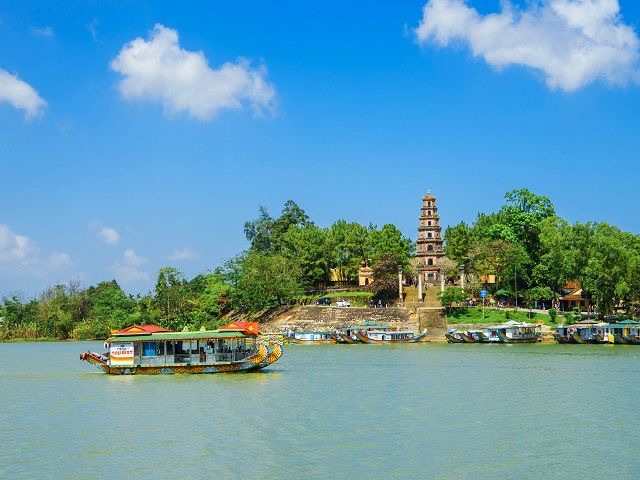
Imperial City of Hue: The Imperial City of Hue is a sprawling complex of palaces, temples, and gardens that served as the seat of the Nguyen Dynasty from the early 19th century until 1945. The city is a UNESCO World Heritage Site and is considered one of Vietnam’s most important cultural and historical landmarks. Visitors can explore the city’s ornate architecture and learn about the fascinating history of the Nguyen Dynasty and its royal court.

Tombs of the Emperors: Located on the Perfume River’s south bank, the Emperors’ Tombs are a series of royal tombs built for the Nguyen Dynasty emperors and their families. Each tomb has its unique architecture and design, reflecting the personality and preferences of the emperor for whom it was built. Visitors can explore the tombs and learn about the fascinating history and culture of the Nguyen Dynasty.
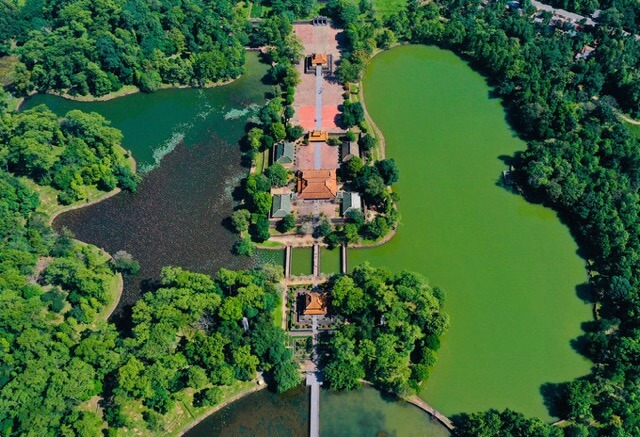
Hon Chen Temple: Hon Chen Temple is a beautiful temple on a hill overlooking the Perfume River. The temple is dedicated to the goddess Thien Y A Na and is an important site for Buddhism and Taoism. The temple is also known for its stunning vistas of the river and the surrounding countryside.
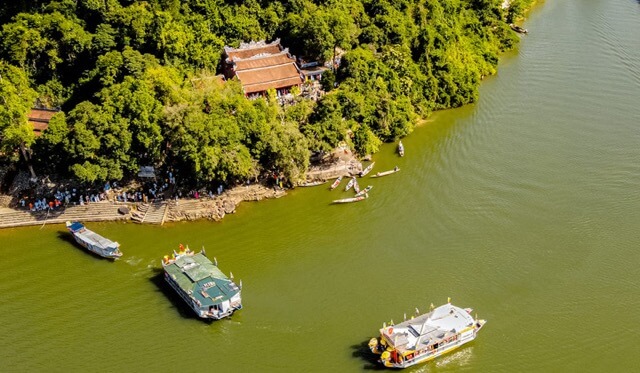
Dong Ba Market: Located near the Truong Tien Bridge, Dong Ba Market is one of Hue’s largest and oldest markets. The market is a bustling hub of activity, with vendors selling everything from fresh produce and seafood to handicrafts and souvenirs. Visitors can immerse themselves in the sights, sounds, and smells of the market and experience the vibrant culture of Hue.
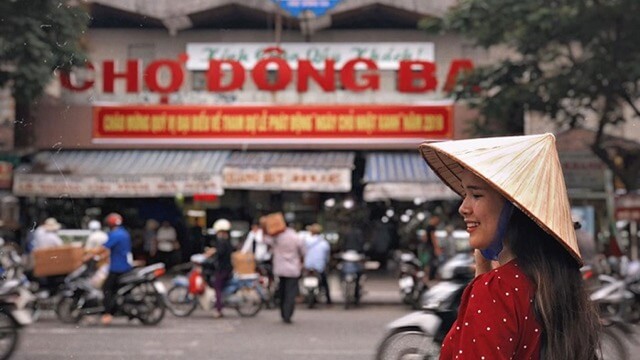
The Perfume River: Inspiring Creativity and Imagination in Hue’s Literary and Artistic Traditions
The Perfume River is not only a vital source of water, food, and income for the people of Hue but has also served as a source of inspiration for many Vietnamese artists and writers throughout history. The river’s natural beauty and cultural significance have been celebrated in poetry, paintings, music, and other art forms.
Poetry: The Perfume River has been a popular subject in Vietnamese poetry for centuries, with many poets drawing inspiration from the river’s gentle current and fragrant scent. The river’s natural beauty has been praised in countless poems, many of which have become beloved classics of Vietnamese literature.
Paintings: The Perfume River has also been a popular subject in Vietnamese paintings, with many artists capturing the river’s tranquil beauty and the surrounding countryside. The river’s winding course, lush greenery, and colorful boats have all been portrayed in different styles and techniques, making it a popular theme for many Vietnamese painters.
Music: The Perfume River has also inspired many Vietnamese musicians, with the river’s gentle flow and fragrant scent as a backdrop to many traditional Vietnamese songs. The river’s cultural significance has also been celebrated in modern pop songs and other forms of contemporary music.
Cultural Events: The Perfume River is also popular for cultural events and festivals. One of them is the Hue Festival, a biennial event that celebrates the cultural heritage of Hue and the surrounding region. The festival features various activities and events, including music performances, traditional dance shows, art exhibitions, and food fairs.

Aside from the Hue Festival, the Perfume River hosts various cultural events throughout the year, including the yearly boat races held during the Mid-Autumn Festival and the spectacular lantern festival held during the Lunar New Year. Over the years, the Perfume River has played an important part in Vietnamese literature, art, and culture, and it continues to inspire and enchant visitors worldwide.
Embark on a Thrilling Vietnam Expedition along the Majestic Mekong River.
Conclusion
Hue’s cultural and environmental legacy is inextricably linked to the Perfume River. It gives visitors a unique glimpse into Vietnam’s rich history and culture. The Perfume River is a must-see destination for anybody interested in history, culture, or natural beauty, with its many sites and attractions, as well as cultural events and festivals.


Related Posts
How To Get To Mekong Delta From Ho Chi Minh City?
The Southwest of Vietnam is known for its sweet, fragrant fruits, stunning natural landscapes, and welcoming locals. However, for a complete experience, visitors must carefully consider how to get to Mekong Delta from Ho Chi Minh City, as the right choice of transport can significantly enhance your journey. Join Joy Journeys to discover this trip’s […]
Memorable Fruit Picking Experience In Mekong Delta Orchards
Southwest Vietnam is a captivating region known for its expansive rivers, vibrant floating markets, and rich cultural diversity. Fruit picking in Mekong Delta orchards is among the most authentic activities to enjoy while visiting this lush area. Join Joy Journeys to uncover this fertile land’s unique and unforgettable experiences! Contents1 Top 5 famous fruit orchards […]
(Amazing) Cu Chi Tunnels Experience For Claustrophobic Visitors
The Cu Chi Tunnels, a vast network stretching over 250 kilometers, are one of Vietnam’s most fascinating historical sites. However, since the tunnels were dug by hand, they can be narrow and dark, which might cause discomfort for some visitors, especially those with claustrophobia. Despite this, the Cu Chi Tunnels remain a safe and captivating […]